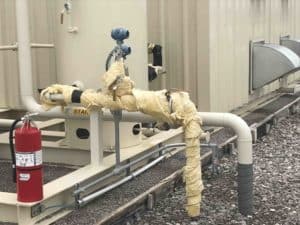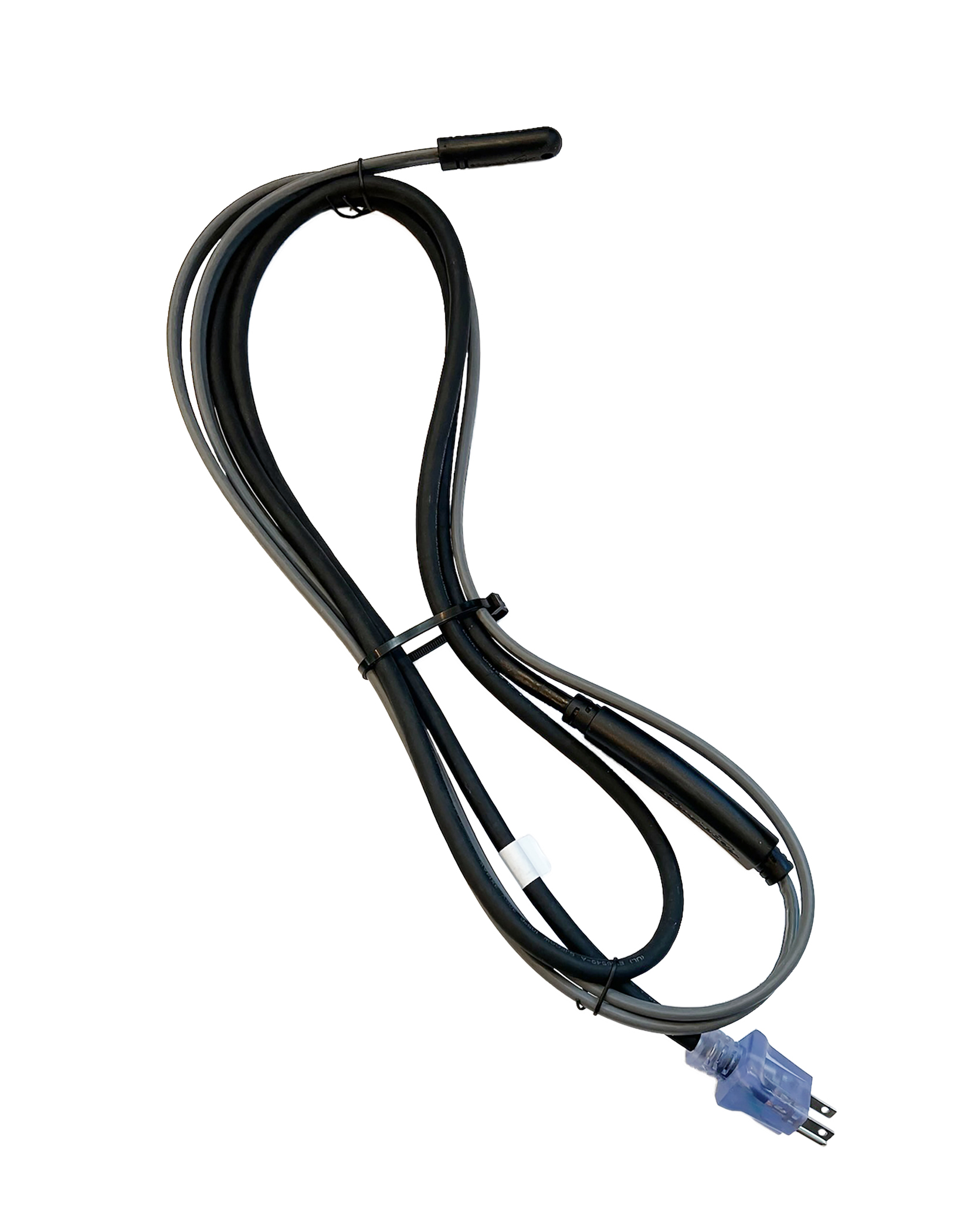Electric heat trace systems provide needed heat to pipes, tanks, and other processes. Maintaining heat trace and knowing how to troubleshoot the system is the key to its long life and reliability.
In order for heat trace to work properly, it must have:
- dry effective insulation
- a reliable power source
- the ability to create heat or have resistance (Ohm’s law)
- resistance to a ground or not have the potential to short out
- power and end seal kits installed properly and water-tight
Without any of these features, electric heat tracing will be less effective and become damaged over time. Don’t let your freeze protection plan become compromised due to an inoperable heating cable.
Don’t let your heat trace system fail when you need it most. An outage during freezing temperatures can wreak havoc, causing pipes to burst and processes to shut down. The costs of such a failure go far beyond just repairing and replacing damaged equipment. There’s also lost revenue from downtime, potential OSHA fines, and environmental fees. Not to mention the disruption to your operations and customers. It’s simply too much risk to take. PowerTrace self-regulating heat trace cable is engineered to provide reliable freeze protection and peace of mind. With advanced polymer heating elements encased in a rugged metal sheath, PowerTrace stands up to moisture, corrosion, and mechanical damage. Precision heating technology detects temperature changes along the pipe and automatically adjusts output, delivering just the right amount of heat. Take control this winter with a heat trace system you can count on.
Challenges of Heat Trace
Heat trace isn’t without its difficulties. Some of the biggest challenges with maintaining heat trace systems are:
-
Out of sight/out of mind: Heat trace is usually underneath insulation and you don’t see it every day.
 Seeing a poor termination or damage to heat trace under the surface is impossible without X-ray vision. Many runs of insulation will also be compromised by personnel stepping on it or from expansion and contraction from heating and cooling, creating cracks in the outer jacket. In both of these common occurrences, the insulation under the surface of the outer jacket will let water and moisture in. The net effect is to render the heat trace useless; without dry insulation, the heat trace cannot generate enough heat to be of any use.
Seeing a poor termination or damage to heat trace under the surface is impossible without X-ray vision. Many runs of insulation will also be compromised by personnel stepping on it or from expansion and contraction from heating and cooling, creating cracks in the outer jacket. In both of these common occurrences, the insulation under the surface of the outer jacket will let water and moisture in. The net effect is to render the heat trace useless; without dry insulation, the heat trace cannot generate enough heat to be of any use.
- Plant automation systems normally are not set up to “see” what is going on with heat trace systems. Many systems in a plant are designed to interface with a plant-wide DCS or central control system drives for motors, flow rates for pumps, etc.. Heat trace systems are normally local only. You would have to walk by to see if it was on or off. When an owner has no visual at the control room, the only way to know if a system is working or not can literally be a pipe locking up or freezing.
- Steam Outs: Often, heat trace owners need to clean out the pipe or vessel to remove residue or build-up. The easiest way to do that is often with high-pressure steam. With steam, the higher the pressure, the higher the temperature. When that temperature exceeds the designed exposure temperature of the heating cable, the heat trace can be rendered useless because it was ruined by the steam out.
- The use of lighted end seals or end-of-circuit lights. Since most heat trace systems are not monitored remotely, signal light use at the end of a trace run has become really popular. Users feel that the light will indicate if a trace circuit is working or not. It doesn’t, though. It only tells you that you have voltage at the end of a run. It doesn’t check for resistance or heat. Signal lights are good in that they signify to users that voltage is there and available, but it has no way of measuring current or resistance.
-
Improperly installed breakers: NEC 427-22 code requires industrial heat trace systems to have a GFEP-rated 30 mA breaker rated for the total amperage load. Not using this type of breaker will cause two primary problems:
- Using less than 30 mA will cause tripping, which is what a ground fault breaker is supposed to do. Due to the fact that self-regulating heat trace is most common, 30mA will give you more cushion to prevent tripping.
- Undersized breakers and oversized circuit lengths will also cause problems with nuisance tripping. Self-regulated heat traces of all manufacturers have an inrush upon initial startup of 2-3x the rated amperage. If you have a run of heat trace that is pulling 20 amps, you could easily trip a 30 amp breaker at startup. To prevent tripping, make sure that your breaker is sized to allow for that startup inrush.
How to Troubleshoot Electric Heat Trace
Testing heat trace systems on a regular basis is key to maintaining systems and ensuring that they work properly. There are six steps in testing or troubleshooting heat trace cable:
- One of the best ways to check for problems with a heat trace system is to walk down the lines on-site. Valves and pumps are often the source of issues as maintenance is done on these items along the line more often than any other location. After a valve is replaced, it is common that the heat trace is not correctly reapplied, and insulation is not reinstalled as originally designed. Look for damaged insulation. Piping insulation looks sturdy enough to stand on, but it’s not. Once someone walks over or jumps on insulation, it crumples. Heated lines and vessels also expand and contract as they heat up and cool down. This can cause cracks or pathways to allow insulation to be ruined. Without walking down the heat trace circuits and observing this, you may never see it. Damaged insulation is responsible for many of the failures in process lines and vessels and can be a primary troubleshooting indicator.
- Make sure that proper voltage is being applied. The best way to do this is to first test at the breaker. Check the integrity of both the power coming to the breaker at the breaker panel, as sometimes power to the facility is not what you thought it was. This reduction or oversupply of voltage can cause problems with heat trace heat output. Following this step, energize the circuit and check the voltage at the end of the heat trace run. Confirming that voltage is acceptable at the end of the run from the supply is key in ensuring that the system has the needed voltage to perform. Voltage checks at the breaker are a primary checkpoint in any troubleshooting plan.
- Ensure that properly rated breakers are installed and in working order. Each heat trace run should have documentation showing the required voltage and current or amperage being pulled. Breakers should allow for the 25% oversize required per code and also for the inrush described above. It is common to apply relay or wire sizing methodology to breaker sizing for self-regulating heat trace circuits. Knowing the amperage of each of your heat trace circuits and how to properly size breakers is key in a good troubleshooting plan for heat trace.
- Check the resistance and wiring of the circuit from the load side of the breaker. Knowing each circuit’s required resistance is essential. From the breaker, check all of the wires, terminations, and heat traces. All of these components are required and critical in running a heat trace circuit. Not checking them all as a system would be a mistake in your troubleshooting efforts.
- Meggering your entire system is one of the best ways to troubleshoot heat problems. Start by meggering each circuit from the load side of the breaker. Following Megger instructions, proper evaluation using a Megger from the control panel is critical. You will be checking the wire, all terminations, and the heat trace from the load side of the breaker. This allows you to test not only the resistance to the ground of the heat trace but also the resistance to the ground of the wire going to the heat trace. Wire and termination in junction boxes can have potential leakage to the ground. This can cause your breaker to trip and shut the system down.
- Megger the heat trace at the power connection, and be sure to follow the megger and heat trace manufacturer instructions. Isolating the individual heat trace circuit will allow you to make sure that the grounding system designed for the heat trace circuit is working properly and has the needed integrity to catch a ground fault should it occur. Without a good solid ground, that would never happen. The ideal megger reading is 2000 megohms on a 1000 Vdc. Setting. Manufacturers will tell you that anything over 20 megohms is acceptable, but keep in mind that 20 megohms is not perfect resistance to ground. Consider replacing that run of heat trace if anything between 20 and “infinite” is seen.
We Know Electrical Heat Trace
Call Powerblanket today for help in troubleshooting your heat trace system or replacement of non working cable with PowerTrace. Our technical expertise and relationships with electrical and insulation installers across North America can help answer any questions you have about your insulation system.
Frequently Asked Questions
How do you test trace heating?
To test trace heating, walk down the lines to inspect for visible issues, ensure the system is running at the correct voltage, verify that properly rated breakers are functioning, and check the resistance and wiring from the load side of the breaker.
How many ohms should a heat trace have?
A heat trace should have a minimum reading of 20 megohms per circuit, which serves as an acceptable benchmark for testing and future maintenance checks.
What causes heat tape to stop working?
Heat tape can stop working due to electrical issues like shorts or improper installation, as well as material degradation from exposure to moisture or extreme temperatures.
Why does heat trace fail?
Heat trace systems often fail due to compromised insulation, improper reinstallation after maintenance, and errors in termination, all of which can render the system ineffective.
Don't let the cold weather stop your business. Powertrace heat trace cable will keep you running smoothly no matter how low the temperatures.







